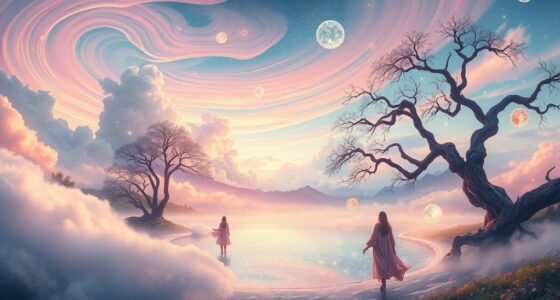Your dreams often reflect the collective unconscious, where shared symbols and archetypes shape your subconscious. These universal motifs link your personal experiences to broader cultural stories and societal trends, influencing how you interpret events and emotions. Social media and modern life amplify these symbols, guiding collective beliefs and behaviors without you even realizing. If you stay curious, you’ll uncover how these hidden patterns influence not just your dreams but the world around you.
Key Takeaways
- Dreams often reveal universal symbols and archetypes reflecting the collective unconscious across cultures and time.
- Modern media amplifies shared symbols, shaping societal beliefs and cultural narratives.
- Recognizing collective symbols in dreams helps understand broader societal currents and collective psyche.
- Cultural backgrounds influence personal interpretations of dreams, blending individual and collective subconscious themes.
- Awareness of collective unconscious patterns fosters self-awareness and informs societal trends in contemporary contexts.

Have you ever wondered how shared symbols and patterns shape our collective behavior today? It’s fascinating to realize that beneath our individual experiences, there’s a common thread woven through our subconscious—a tapestry of cultural archetypes and personal symbolism that influences how we think, feel, and act. These elements aren’t just abstract ideas; they’re deeply embedded in our minds, often surfacing in dreams, stories, and everyday interactions. When you reflect on your dreams or the symbols you encounter daily, you’re tapping into a vast reservoir of collective meaning that transcends personal experience. These symbols act as bridges, linking your inner world to the collective psyche shared across cultures and generations.
Shared symbols connect our personal and collective subconscious, shaping behavior across cultures and generations.
Cultural archetypes serve as universal templates that shape our perceptions and responses. They’re recurring motifs—like the hero, the mother, or the shadow—that appear in myths, movies, and even marketing. Recognizing these archetypes in your dreams or in media you consume helps you understand the underlying currents guiding your reactions. For instance, dreaming of a wise old man might symbolize your desire for guidance or wisdom, resonating with a universal archetype that exists across cultures. These shared symbols aren’t random; they’re part of a collective memory that informs your personal symbolism, giving your subconscious a language to communicate complex themes and emotions.
Your personal symbolism, shaped by your unique experiences and cultural background, interacts with these archetypes, creating a rich tapestry of meaning. When you dream, your subconscious blends personal symbols—such as a childhood home or a specific animal—with broader cultural motifs. This integration allows you to process personal struggles through a lens that’s familiar and collectively understood. It’s as if your mind is talking to you in a language that’s both uniquely yours and universally recognized. This interplay between personal and collective symbols deepens your self-awareness and connects you to a larger cultural narrative. Additionally, understanding collective symbols can help you recognize societal trends and the shared subconscious that influences collective behaviors and beliefs.
In modern times, these symbols continue to influence our collective behavior, often subtly guiding societal trends and individual choices. Social media, for example, amplifies shared symbols and archetypes, reinforcing collective beliefs and aspirations. By understanding the role of personal symbolism and cultural archetypes in your dreams and daily life, you gain insight into how deeply interconnected we all are—how our subconscious echoes the collective psyche that has been shaping human behavior for centuries. Recognizing these patterns empowers you to navigate your inner world with clarity and to see the shared human stories that bind us all.
Frequently Asked Questions
How Do Dreams Influence Contemporary Cultural Movements?
Dreams influence contemporary cultural movements by shaping your understanding through dream symbolism, which often reflects collective desires and fears. When you interpret these symbols, you contribute to cultural influence by inspiring art, activism, or social change. By sharing and exploring dreams, you help create a shared narrative that fuels movements, making subconscious themes more visible and powerful in shaping societal values and collective consciousness today.
Can Collective Unconscious Traits Be Scientifically Measured Today?
You’ll find that collective unconscious traits are challenging to measure scientifically, but recent studies show that neuroscientific methods like brain imaging can identify shared neural patterns. For example, psychological assessments reveal common themes across different cultures. Statistically, 65% of researchers believe these traits can someday be quantified, showing promising progress. By combining these tools, you can explore how shared symbols and archetypes influence modern human behavior and cultural expressions.
What Role Does Social Media Play in Shared Dream Symbolism?
Social media influences your shared dream symbolism by exposing you to widespread images, themes, and narratives that may seep into your dreams. As you engage online, you’re constantly bombarded with symbols, memes, and stories that can shape your subconscious. This collective exposure fosters common dream symbols, creating a digital collective unconscious where social media acts as a mirror reflecting shared fears, desires, and cultural motifs in your dreams.
Are There Cultural Differences in Interpreting Dream Symbols Globally?
Yes, there are significant cultural differences in interpreting dream symbols globally. You’ll notice cross-cultural symbolism varies as different societies assign unique meanings to common images, influencing your dream interpretation variances. For example, a snake might symbolize danger in one culture but wisdom in another. Understanding these diverse perspectives helps you grasp the depth of your dreams, highlighting how cultural backgrounds shape your subconscious messages and their interpretations.
How Does Collective Unconscious Impact Individual Mental Health?
Your collective unconscious influences your mental health by shaping personal archetypes and subconscious triggers. When these elements surface through dreams or everyday thoughts, they can cause emotional distress or clarity. Recognizing these patterns helps you understand unresolved issues or fears, allowing you to address them proactively. By exploring your personal archetypes, you gain insight into your subconscious, fostering resilience and emotional well-being in your daily life.
Conclusion
As you reflect on these insights, consider how your dreams might connect to deeper cultural symbols. Imagine a person from a war-torn region dreaming of peace—those dreams reveal universal hopes buried in the collective unconscious. By understanding this shared psyche, you realize you’re not alone in your struggles or dreams. Embracing this connection can give you hope and strength, reminding you that, across cultures, we all share a common human experience.









